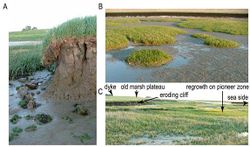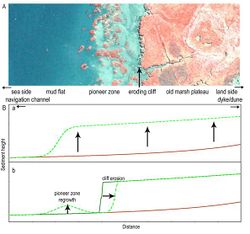Dynamics, threats and management of salt marshes
UNDER CONSTRUCTION
Contents


Processes and mechanisms driving natural dynamics & ecosystem development
Coastal areas, like estuaries, are high energetic environments where organisms are exposed to hydrodynamic forces from waves and tidal currents. Ecosystem engineering species (Jones et al., 1997) play an important role in shaping the intertidal landscape (Temmerman et al., 2007[1]; Weerman et al., 2010). Coastal vegetation, like salt marsh vegetation, are ecosystem engineers in that they can strongly attenuate hydrodynamic energy from tidal current and waves (Bouma et al., 2005[2], 2007[3], 2010). This has a positive effect on sediment accretion rates, and hence results in increased sediment elevation. In turn, increased sediment elevation stimulates plant growth because the inundation duration for the vegetation is shortened. This results in positive feedbacks between plant growth and sediment accretion. Implications of this feedback can be observed in the field in the form of dome shaped hummocks of cord‐grass (Spartina spp.). They can be found on the mud‐flats seaward of the salt marsh edge (Figure 1), where the salt marsh is developing.
Feedbacks between hydrodynamic forces, sediment accretion and vegetation are key processes in shaping salt marshes (Temmerman et al., 2007[1]; van Wesenbeeck et al., 2008). Locally the canopy of a vegetation stand can attenuate currents and waves which result in a net sedimentation. However, the same canopy also obstructs the flow, thereby diverting it and increasing flow velocities in the areas adjacent to the canopy because of conservation of mass and energy (Bouma et al., 2009). This biomechanical stress diversion can result in negative feedbacks on vegetation settlement and growth at some distance from the canopy (van Wesenbeeck et al., 2008). However, the outcome of these feedbacks may be dependent on the local context, seeing as these kinds of feedbacks are density‐dependent (Bouma et al., 2009). In other words, the strength of these negative feedbacks may vary with vegetation age, composition, or even the sediment type it is growing in (van Hulzen et al., 2006[4]). Overall these feedbacks cause complex patterns of gullies and hummocks until eventually a mature marsh arises, dissected by a complex drainage system (Kirwan and Murray, 2007; Temmerman et al., 2007[1]).
Many marshes are characterized by a cyclic nature, where marsh formation is followed by destruction (Figure 2). After a period of lateral extension, large scale lateral erosion of salt marshes can set in when the marsh edge becomes disturbed, a phenomenon often referred to as cliff erosion (see Figure 1.a, Figure 2.B.b; Allan 2000[5]; Adam 2002[6]). For example, a disturbance from a storm surge can initialize this erosion process by forming a steep slope. At the disturbed edge, sediment is more vulnerable to wave action and currents. So once a cliff starts to erode, this process will not easily be stopped. Thus the steep slope remains particularly vulnerable for waves and currents until it is protected by new marsh vegetation emerging in front of the cliff. The initiation of cliff erosion is intrinsic to natural temporal salt marsh dynamics (Allen 2000 [5]; van de Koppel et al., 2005). However, human activities can contribute significantly to the severity of the cliff erosion (Allen 2000; Adam, 2002). For example, shipping traffic and dredging activities can increase exposure to currents and waves, thereby increasing the pace at which lateral erosion proceeds. Moreover, human induced activities may also take away the space for natural marsh recovery in front of the eroding cliff. The latter would result in the permanent loss of a marsh.
Loss of salt marsh habitat due to lateral erosion is a major problem across the world, especially in those locations where the marsh does not seem to recover. For example, the marshes in the Venice Lagoon (Italy) laterally erode with 1.2‐2.2 m yr-1at their seaward edges (Day et al., 1998) .The estuaries of South‐East England lose about 4,000 m²yr-1 of tidal marsh area due to erosion at the seaward edges and channel widening of creeks dissecting the marsh (Hughes and Paramor, 2004). However, the main drivers of salt marsh erosion are still subject of debate (Wolters et al., 2005). Generally, it is believed that human activities are responsible for increasing erosion (Allen 2000; Adam 2002; Wolters et al., 2005).Pollution, shipping and dredging are some of the proposed anthropogenic causes. In addition, climate change and sea level rise receivemuch attention as a cause of salt marsh disappearance. In addition to these extrinsic forcing factors, intrinsic biological processes are also proposed (Allen 2000; Wolters et al., 2005). For example, vegetation‐sediment feedbacks (Allen 2000) and sediment destabilization by bioturbation and herbivory by worms (Hughes and Paramor, 2004; van der Wal and Pye; 2004) and geese (Dionne 1985) can also result in erosion of salt marshes. A fundamental understanding of the mechanisms that control cliff initiation and salt marsh re‐establishment in front of a cliff is needed in order to protect and manage these highly dynamic salt marsh ecosystems.
Vulnerability &threats to salt marshes
Key processes to focus on for maintaining ecosystems integrity
Current management practices
see also
References
- ↑ 1.0 1.1 1.2 TEMMERMAN, S.; BOUMA, T.J.; VAN DE KOPPEL, J.; VAN DER WAL, D.; DE VRIES, M.B.; HERMAN, P.M.J.(2007). Vegetation causes channel erosion in a tidal landscape. Geology. 35(7), 631-634. Available from: http://www.vliz.be/imis/imis.php?module=ref&refid=114118
- ↑ BOUMAT.J.,DE VRIES M.B., LOW E., PERALTA G., TNCZOSI.C.,VANDEKOPPELJ., HERMAN P. M. J., 2005. Trade‐offs Related to Ecosystem Engineering: A Case Study on Stiffness of Emerging Macrophytes. Ecology. 86, 2187‐2199.
- ↑ BOUMA, T.J.; VAN DUREN, L.A.; TEMMERMAN, S.; CLAVERIE, T.; BLANCO-GARCIA, A.; YSEBAERT, T.J.; HERMAN, P.M.J. (2007). Spatial flow and sedimentation patterns within patches of epibenthic structures. Cont. Shelf Res.. 27(8): 1020-1045. dx.doi.org/10.1016/j.csr.2005.12.019 Available from:http://www.vliz.be/imis/imis.php?module=ref&refid=114437
- ↑ VAN HULZEN J.,VAN SOELEN J.,HERMAN P.M.J., BOUMA T.J., 2006.The significance of spatial andtemporal patterns of algal mat deposition in structuring salt marsh vegetation. J Veget Sci.. 17, 291‐298.
- ↑ 5.0 5.1 ALLEN J.R.L., 2000. Morphodynamics of Holocene salt marshes: a review sketch from the Atlantic and Southern North Sea coasts of Europe. Quaternary Science Reviews. 19:, 1155-1231.
- ↑ ADAM P., 2002. Salt marshes in a time of change. Environmental Conservation. 29, 39‐61
Please note that others may also have edited the contents of this article.
|